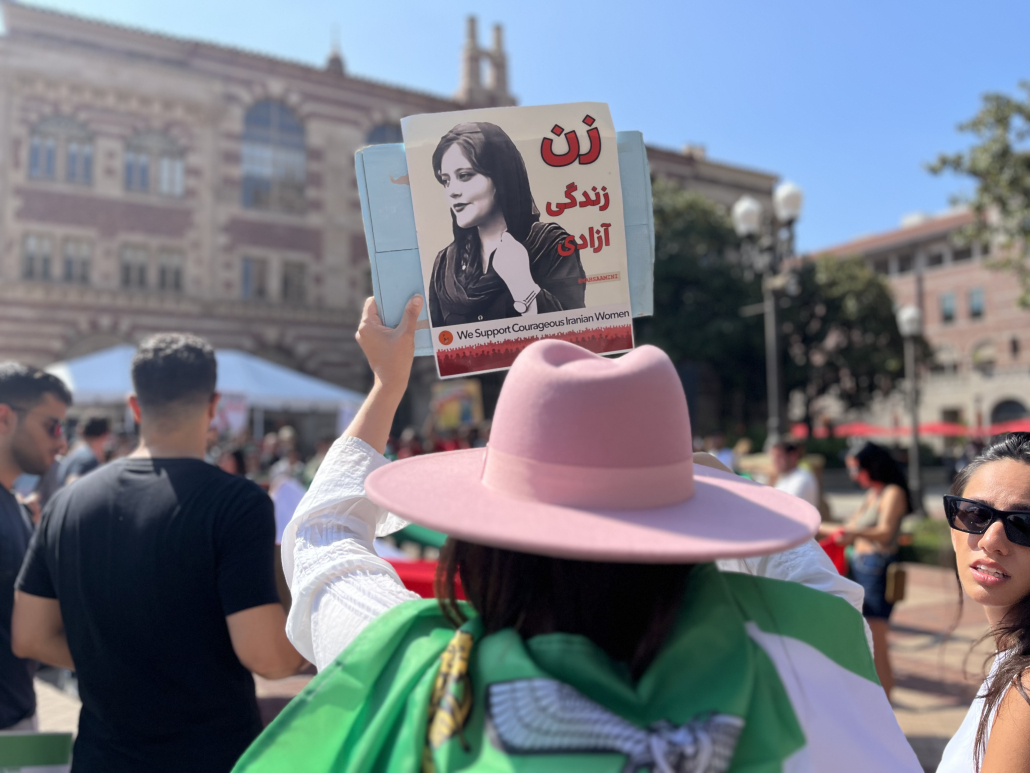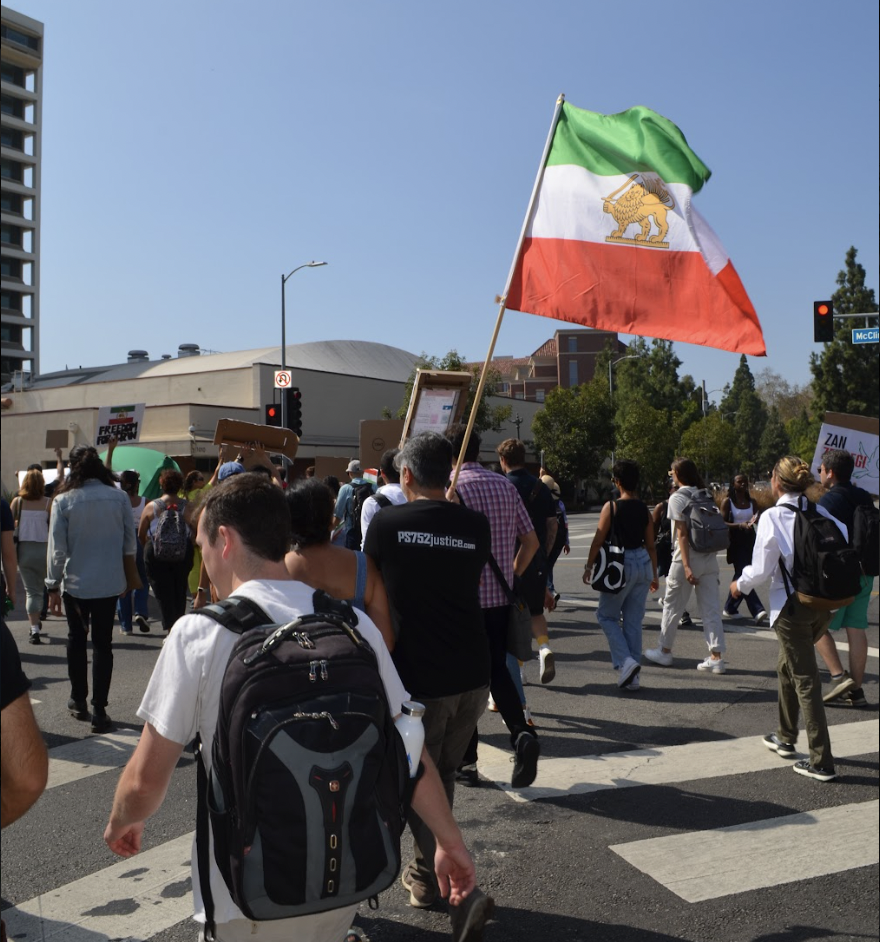USC community marches in support of Mahsa Amini

More than 60 USC students, faculty and alumni rallied before Tommy Trojan Friday afternoon to demonstrate solidarity with Mahsa Amini, whose death has sparked massive nationwide protests in Iran.
Amini, a 22-year-old woman from the Kurdistan province of Iran, died on Sept. 16 in a Tehran hospital, three days after she was arrested and detained by Iranian morality police for not properly wearing her hijab.
The police claimed that Amini fell into a coma when she stayed at a detention center to receive training on hijab laws. She was later transferred to a hospital and died due to a heart attack. The Iranian coroner released a new report Friday verifying that Amini didn’t die due to blows to the head or limbs, but instead from multiple organ failures caused by hypoxia.
Amini’s relatives denied she had suffered any heart condition before; instead, they stated with the support of eyewitnesses that the morality police had beaten Amini after they arrested her.


The march started in Hahn Plaza and continued along Trousdale Parkway to USC Village, where protesters stopped at the Hecuba statue to speak out their pain and hopes for change in Iran.
“[Amini] is one of the thousands of lives that [are] being captured by Islamic Republic of Iran,” said Nazanin, a research fellow at the Annenberg Innovation Lab, in a speech during the march. Nazanin requested that only her first name be used in fear of political retaliation. “We have the opportunity to say it loud, to shout … This is the first time that I can shout my voice without the fear of teargas.”
“We have the opportunity to say it loud, to shout … This is the first time that I can shout my voice without the fear of teargas.”
Nazanin, a research fellow at the Annenberg Innovation Lab
Nooshin Neshkaty, a USC graduate from Iran, said she felt “furious, sad and mad” when she first heard the news of Amini’s death.
“From the first day that this government has taken place in Iran, they have taken the rights away from women,” Neshkaty said. “Hijab is one area of the oppression that you see toward women, but there are many oppressive rules toward women.”
Protesters chanted “women, life, freedom,” “freedom for Iran” and “Mahsa Amini” to show their support for the ongoing protests for women’s rights in Iran.
One of the individuals participating at the event, Rana Aghababazadeh, an Iranian American senior majoring in biotechnology, said the lack of freedom for women in Iran has been pervasive and overbearing.
“[There are] laws that prevent women from having basic rights that people in America, I think, take for granted,” Aghababazadeh said. “We don’t think about the fact that women can’t become judges in Iran … [that] we cannot sing in public, we cannot dance in public, men and women are not allowed to hold hands in public.”
Amid the widespread protests, Iran began shutting down the internet Sept. 19 and restricted the sharing of videos that highlight brutal clashes between civilians and police. On Friday, the mother of teenager Nika Shakarami accused Iranian authorities of murdering her daughter, who died during protests.


Iran Human Rights, a nonprofit organization in Norway, reported at least 154 protesters, including children, killed and thousands arrested since the protests began last month. This represents the largest death toll since the violent crackdown on protests against abrupt fuel price increases in November 2019. However, there is a growing feeling among USC protesters, human rights activists and policy experts that current protests mark a turning point in Iran’s policy on human rights.
“I’ve never seen such an international response to a movement in Iran,” Aghababazadeh said. “I’ve never seen Iranians rally the way they have all across the world in so many different countries.”
“I’ve never seen Iranians rally the way they have all across the world in so many different countries.”
Rana Aghababazadeh, a senior majoring in biotechnology
Niki Tavakoli, a doctoral student studying biomedical engineering who attended Friday’s march, said the protest helps to spread the voice of Iran to the international world.
“It feels like, with this movement, we’ve reached a point of no return,” Tavakoli said. “If this stops, eventually, it’s going to get even worse.”
President Carol Folt also shared her support for Iranian women in an Instagram post Sept. 28.
“Our hearts go out to the Iranian women risking their lives for freedom and dignity. I join many of the members of USC’s Iranian community in admiration of their bravery,” Folt wrote.
Morteza Dehghani, an associate professor of psychology and computer science, attended the march and praised Folt’s initial response to the ongoing Iranian situation.
“The President [made the] right move. She tweeted and expressed her support early on, which is something the previous administration would have never done. We thank President Folt for that, but we need more,” Dehghani said.


Another faculty member, Assal Habibi, also took part in Friday’s events. She explained that she felt USC needed to do more to recognize the effect of the recent events on the USC student body, in which there is, according to Dehghani, the “largest number of Iranian students in any university outside of Iran.”
“[Students] have a hard time describing to professors and their friends and classmates that this is a giant emotional burden,” Habibi said. “As far as USC goes, we want the administration to support the Iranian students that are already here, [because] maybe they can’t meet academic deadlines [or] have friends who have been arrested in Iran.”
Habibi also suggested accommodating prospective USC students by deferring application deadlines, because Iran is “going through war in a different way.”
Aghababazadeh, however, said she feels Folt’s initial response was not adequate for the scale of the matter.
“I am not happy with the way USC has responded to this,” Aghababazadeh said. “For Black Lives Matter, as they should, USC put out statements, put out posts about Black History Month. For [the Russian invasion of Ukraine], they issued a statement and an email. All we’ve seen from Carol Folt is an Instagram post of less than 20 words.”
Dehghani said supporting the movement through traditional means of fundraising and financial aid is “very tricky [for all involved] because of all the economic sanctions against Iran.”
“If you’re raising money, the money cannot directly go into Iran. You have to think of alternative ways of supporting,” Dehghani said. “For example, there are several GoFundMe pages for supporting specifically students whose parents are in Iran, whose families are in Iran.”
Friday’s march at USC was one of a series of demonstrations that have taken place in Los Angeles. On Oct. 1, thousands of protestors also congregated outside L.A. City Hall. The day after, a large rally also took place in Westwood. Those who care about women’s freedoms in Iran, Aghababazadeh said, should continue in the same vein.
“It starts with grassroots movements and getting our representatives to get the country to acknowledge what’s happening in Iran,” Aghababazadeh said.

